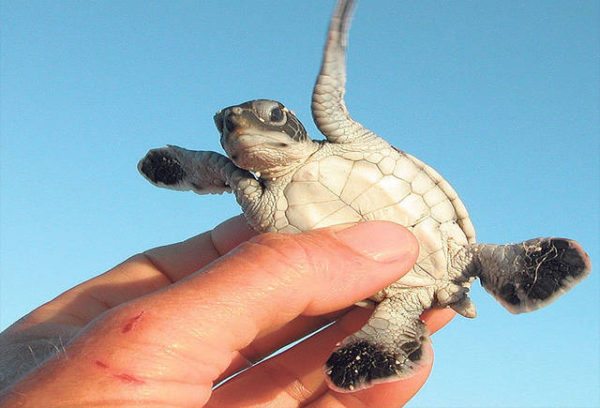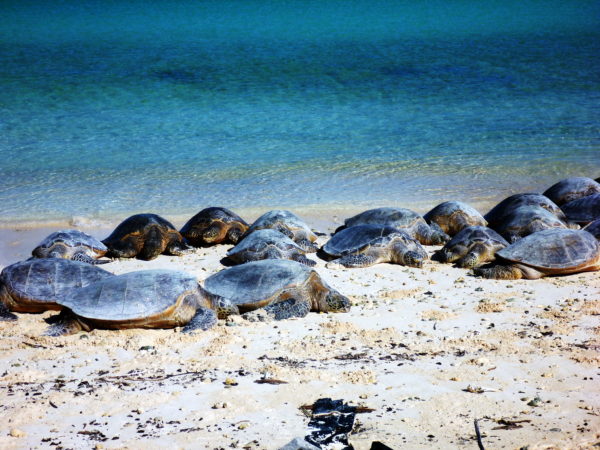Published in the Ocean Watch column, Honolulu Star-Advertiser © Susan Scott
January 27, 2018
Three weeks ago I wrote that an increasing number of green sea turtles, called honu in Hawaiian, are swimming to Midway Atoll to rest on a particular stretch of sand.
 A lost honu hatchling flaps its flippers in an effort to run or swim.
A lost honu hatchling flaps its flippers in an effort to run or swim.
It was released at the shoreline and swam away within seconds.
©2018 Susan Scott
Researchers think that greens come out to warm up. Only the greens of the Galapagos, Australia and Hawaii haul out to sunbathe.
Haul is a good word for it. Because sea turtles have flippers for feet, moving their heavy bodies above the waterline is a slog.
During my albatross work at Midway two years ago, I watched several 200-or-so-pound turtles dig their front fins into the sand and lurch up the beach, one laborious step at a time. I felt exhausted just watching.
On Jan. 20 a friend working at Midway sent an email with the subject “How many turtles?” Her photo showed turtles resting flipper to flipper on that same beach. “The count on this day was contested,” Jill wrote. “Either 69 or 70 depending on whether the computer image was enlarged.”
 A few of Midway’s turtles basking on their favorite beach.
A few of Midway’s turtles basking on their favorite beach.
The two in the background are dark because they’re still wet.
©2018 Susan Scott
Because few, if any, of these turtles hatched on Midway (it’s not yet a significant nesting site), I wondered how they know to go there. Perhaps there’s some kind of turtle telegraph advertising Midway as a great place to soak up the sun.
Another friend recently sent a smile-inducing hatchling video called “Turtles on a treadmill”; watch it at goo.gl/YhEqq7.
At night, when hatchlings emerge from their sand nests, they run toward the brightest light. In nature that’s the ocean. In urban areas, however, artificial light, known as skyglow, trumps the sea for luminosity.
When hatchlings head toward human-produced light, Florida researchers wondered whether the energy they used running around left the turtles exhausted when they finally reached the ocean.
To test this, workers placed hatchlings on a belt sander treadmill, using a light at the front as a lure. After the turtles had run up to 500 yards, researchers dressed each in a pink swimsuit and placed it in a tank of seawater. Tiny monofilament leashes attached to the suit’s back caused the turtles to swim in place for two hours.
Good news. Both the treadmill and lost-on-the-beach hatchlings rested longer than those of nondisoriented turtles, and that apparently helps the babies conserve energy. Blood and respiration tests showed that even after sprinting the length of five football fields, the baby turtles swam as well as the hatchlings that headed straight to sea.
The bad news is that baby turtles gone astray are easy pickings for predators such as cats, dogs, mongooses and seabirds. And if the hatchlings are still out on the sand after the sun rises, they soon become crispy critters.
Hooray for flippers. After seeing the photo of 70 honu basking on Midway’s beach, and watching hatchlings run on their treadmill, I’m giving green sea turtles a big high-one.